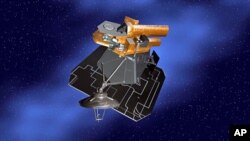A NASA spacecraft is closing in on the Hartley 2 comet to take photographs from a distance of about 700 kilometers.
In recent weeks, the Hartley 2 comet made one of the closest approaches to Earth of any comet in centuries. On November 4, Hartley 2 will be close enough to NASA's Deep Impact spacecraft to give scientists the best ever extended view of a comet.
The spacecraft will use two telescopes with digital color cameras and an infrared spectrometer to gather detailed information, as the probe flies past the icy, dusty comet.
Tim Larson of NASA's Jet Propulsion Laboratory is project manager for the Extrasolar Planet Observation and Characterization, and Deep Impact Extended Investigation, or EPOXI, mission. He says scientists are expecting the unexpected.
"Every time we fly by a comet, we're surprised with what we see," says Larson. "We see new things that raise a lot of new questions."
The U.S. space agency says it is important to study comets because astronomers theorize they are part of a collection of gas, ice, rocks and dust that formed the outer planets of our solar system about 4.5 billion years ago. Some scientists say that comets originally carried some of the water and organic compounds that make up life on our planet.
This will be the fifth time that a spacecraft has been close enough to photograph a comet's core.
"And so, this is a really unique opportunity to be able to go in and do some straight up comparison between two different comets, and being able to see what kind of features are common between them, what kind of features maybe are really primordial -- from when they're first formed and are common to all comets -- [and] what features change with each orbit as they come around the sun," Larson says.
The Hartley 2 comet is named for Malcolm Hartley, the astronomer who discovered it in 1986.
NASA Readies for Comet Flyby










